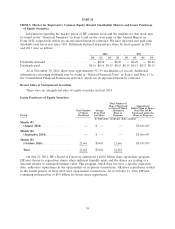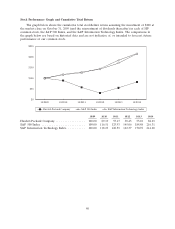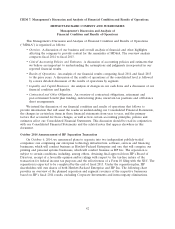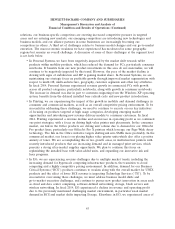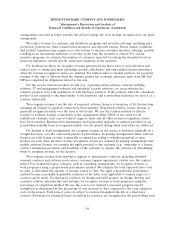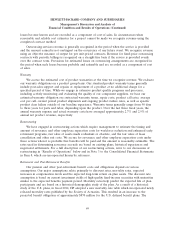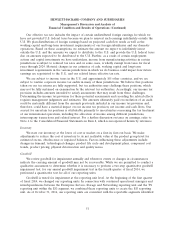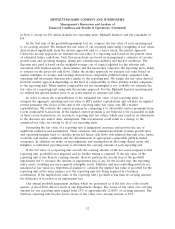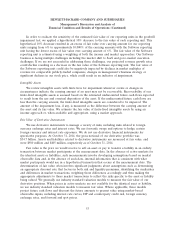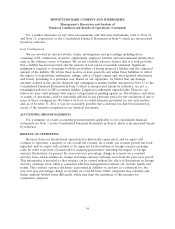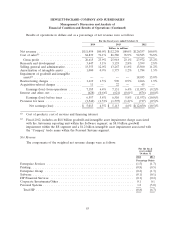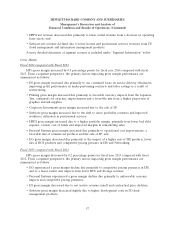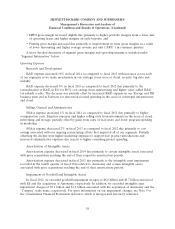HP 2014 Annual Report Download - page 56
Download and view the complete annual report
Please find page 56 of the 2014 HP annual report below. You can navigate through the pages in the report by either clicking on the pages listed below, or by using the keyword search tool below to find specific information within the annual report.HEWLETT-PACKARD COMPANY AND SUBSIDIARIES
Management’s Discussion and Analysis of
Financial Condition and Results of Operations (Continued)
arrangements executed in future periods, but will not change the total revenue recognized for any given
arrangement.
We reduce revenue for customer and distributor programs and incentive offerings, including price
protection, promotions, other volume-based incentives and expected returns. Future market conditions
and product transitions may require us to take actions to increase customer incentive offerings, possibly
resulting in an incremental reduction of revenue at the time the incentive is offered. For certain
incentive programs, we estimate the number of customers expected to redeem the incentive based on
historical experience and the specific terms and conditions of the incentive.
For hardware products, we recognize revenue generated from direct sales to end customers and
indirect sales to channel partners (including resellers, distributors and value-added solution providers)
when the revenue recognition criteria are satisfied. For indirect sales to channel partners, we recognize
revenue at the time of delivery when the channel partner has economic substance apart from HP and
HP has completed its obligations related to the sale.
For the various software products we sell (e.g., operating system software, network enabling
software, IT and management software and enterprise security software), we assess whether the
software products were sold standalone or with hardware products. If the software sold with a hardware
product is not essential to the functionality of the hardware and is more-than-incidental, we treat it as a
software deliverable.
We recognize revenue from the sale of perpetual software licenses at inception of the license term,
assuming all revenue recognition criteria have been satisfied. Term-based software license revenue is
generally recognized ratably over the term of the license. We use the residual method to allocate
revenue to software licenses at inception of the arrangement when VSOE of fair value for all
undelivered elements, such as post-contract support, exists and all other revenue recognition criteria
have been satisfied. Revenue from maintenance and unspecified upgrades or updates provided on an
if-and-when-available basis is recognized ratably over the period during which such items are delivered.
For hosting or SaaS arrangements, we recognize revenue as the service is delivered, generally on a
straight-line basis, over the contractual period of performance. In hosting arrangements where software
licenses are sold, license revenue is generally recognized according to whether perpetual or term
licenses are sold, when all other revenue recognition criteria are satisfied. In hosting arrangements that
include software licenses, we consider the rights provided to the customer (e.g., ownership of a license,
contract termination provisions and feasibility of the customer to operate the software) in determining
when to recognize revenue for the licenses.
We recognize revenue from fixed-price support or maintenance contracts, including extended
warranty contracts and software post-contract customer support agreements, ratably over the contract
period. For certain fixed-price contracts, such as consulting arrangements, we recognize revenue as
work progresses using a proportional performance method. We estimate the total expected labor costs
in order to determine the amount of revenue earned to date. We apply a proportional performance
method because reasonably dependable estimates of the labor costs applicable to various stages of a
contract can be made. On fixed-price contracts for design and build projects (to design, develop and
construct software infrastructure and systems), we recognize revenue as work progresses using the
percentage-of-completion method. We use the cost-to-cost method to measure progress toward
completion as determined by the percentage of cost incurred to date compared to the total estimated
costs of the project. Total project costs are subject to revision throughout the life of a fixed-price
contract. Provisions for estimated losses on fixed-price contracts are recognized in the period when such
48



